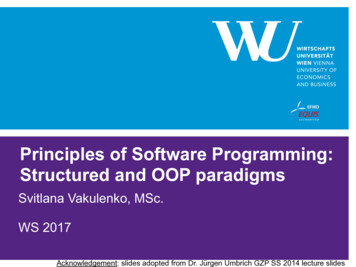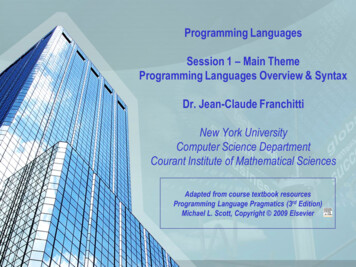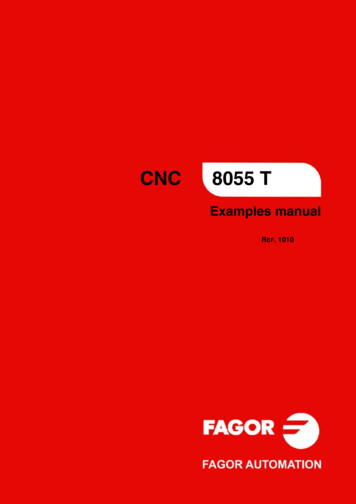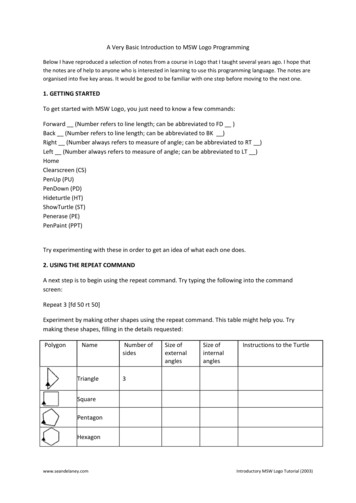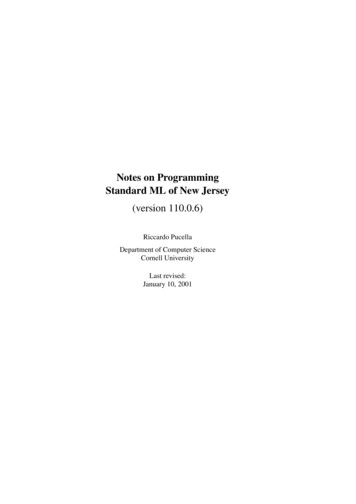
Transcription
Notes on ProgrammingStandard ML of New Jersey(version 110.0.6)Riccardo PucellaDepartment of Computer ScienceCornell UniversityLast revised:January 10, 2001
ii
PrefaceThe impetus behind these notes was the desire to provide a cohesive description ofStandard ML of New Jersey, an interactive compiler and environment for StandardML. The goal is to end up with a complete user guide to the system, inclduing thelibraries, the tools and the extensions, as well as a tutorial on how to write “real”applications, centered around the use of the module system and the compilationmanager. Other reasons include the desire to provide hands-on examples of how touse some maybe poorly understood features or features with an interface differentfrom what one may be used to. Examples of such features include sockets, theinput and output subsystem, the readers approach to text scanning and the use ofcontinuations to handle non-local control-flow. All in all, this would be a repositoryfor snippets of SML and SML/NJ programming lore.These notes are not a tutorial introduction to Standard ML. There exists excellent introductory material, available both commercially or freely over the Internet.These notes complement this literature by focusing on the Standard ML of NewJersey environment. The first part of these notes does given an overview of thelanguage, but a quick one and without highlighting some of the subtleties of thelanguage. Better writers than I have written better introductory material and I urgeyou to read those first. References are given in the chapter notes of Chapter 1. Igo in somewhat more details when describing the Basis Library, since some of theunderlying ideas are fundamental to the overall programming philosophy. Unfortunately, that chapter is long, boring and reads more like a reference manual thana tutorial. Throughness and precision at odds with readability. With luck, enoughsample code and tutorial material is interspersed to lighten the mood. In the courseof the notes, I take the opportunity to describe more advanced topics typically notcovered in introductory material, such as sockets programming, signals handling,continuations, concurrency. Some of these subjects are discussed in advanced programming language courses, which not every one has taken or plan to take. Someof these subjects are hardly discussed and one needs to rummage technical papersor source code.These notes are quite obviously a work in progress. As such, any comments oriii
ivPREFACEsuggestions will be more than welcome. This version includes chapters 1 through7. Planned chapters for the end of spring of 2001 include:Chap. 8 : ML-Lex: A Lexical Analyzer GeneratorChap. 9 : ML-Yacc: A Parser GeneratorChap. 10 : Input and OutputChap. 11 : SocketsChap. 12 : Regular ExpressionsChap. 13 : SML/NJ ExtensionsChap. 14 : ContinuationsIn the long run, chapters on the foreign function interface, CML, eXene, readerbased lexing and parsing, prettyprinting and programming reactive systems areplanned, as well as sample applications including a matrix package, an interactivetheorem prover, a tool to generate simple language front ends, a graphical game àla MineSweeper, and a simulation. Suggestions on content will also be welcome.NotationIn the text, sample code is written in italics. Types are written using more mathematical notation, namely tuple types are given as int int, and function types as int int.Acknowledgments
ContentsPrefaceiii1112345612Introduction1.1 Standard ML . . . . . . . .1.2 Standard ML of New Jersey1.3 History of the system . . . .1.4 Availability and resources . .1.5 Installation . . . . . . . . .1.6 Getting started . . . . . . . .Notes . . . . . . . . . . . . . . .IStandard ML152The Core Language2.1 Basic types and expressions .2.2 Tuples and records . . . . .2.3 Declarations . . . . . . . . .2.4 Pattern matching . . . . . .2.5 Functions . . . . . . . . . .2.6 Polymorphism . . . . . . . .2.7 Recursion . . . . . . . . . .2.8 Lists . . . . . . . . . . . . .2.9 Equality . . . . . . . . . . .2.10 References . . . . . . . . . .2.11 Exceptions . . . . . . . . . .Notes . . . . . . . . . . . . . . .17171920232732343838404142.v.
vi34CONTENTSThe Module System3.1 Structures . . . . . . . . . .3.2 Signatures . . . . . . . . . .3.3 Functors . . . . . . . . . . .3.4 Programming with modules .Notes . . . . . . . . . . . . . . .454550586262The Basis Library4.1 Overview . . . . . . . . .4.2 Basic types . . . . . . . .4.3 More on strings . . . . . .4.4 Aggregate types . . . . . .4.5 Input and output . . . . . .4.6 System functions . . . . .4.7 Time and dates . . . . . .4.8 Compatibility with SML’90Notes . . . . . . . . . . . . . .6565688692102106112118120.II Standard ML of New 717767The Interactive Compiler5.1 Controlling the runtime system5.2 Controlling the compiler . . .5.3 Prettyprinting . . . . . . . . .5.4 Heap images . . . . . . . . . .5.5 Unsafe operations . . . . . . .Notes . . . . . . . . . . . . . . . .The Compilation Manager6.1 Overview of CM . . . . .6.2 Group hierarchies . . . . .6.3 Tools . . . . . . . . . . . .6.4 A simple configuration tool6.5 Technicalities . . . . . . .Notes . . . . . . . . . . . . . .The SML/NJ Library1797.1 Overview . . . . . . . . . . . . . . . . . . . . . . . . . . . . . . 1797.2 Types and data structures . . . . . . . . . . . . . . . . . . . . . . 180
viiCONTENTS7.3 Arrays and vectors . . . . . . . .7.4 Sets and maps . . . . . . . . . . .7.5 Hash tables . . . . . . . . . . . .7.6 Sorting . . . . . . . . . . . . . . .7.7 Formatting . . . . . . . . . . . . .7.8 Handling command-line arguments7.9 Miscellaneous functionality . . . .Notes . . . . . . . . . . . . . . . . . .186191196202206212216223Bibliography225A SML/NJ Grammar235
viiiCONTENTS
List of 264.274.284.294.30The structure General . . . . . . .The structure Bool . . . . . . . . .The structure Option . . . . . . .The signature CHAR . . . . . . .The signature STRING . . . . . .The signature INTEGER . . . . .The signature WORD . . . . . . .The signature REAL . . . . . . . .The signature MATH . . . . . . .The signature SUBSTRING . . . .The structure StringCvt . . . . . .The structure List . . . . . . . . .The structure ListPair . . . . . . .The structure Vector . . . . . . . .The structure Subvector . . . . . .The structure Array . . . . . . . .The structure Array2 . . . . . . .The structure TextIO . . . . . . .The structure OS . . . . . . . . .The structure OS.FileSys . . . . .The structure OS.Path . . . . . . .The structure OS.Process . . . . .The structure Unix . . . . . . . .The structure CommandLine . . .The structure Time . . . . . . . .The structure Date . . . . . . . .Formatting characters for Date.fmtThe structure TimeZone . . . . . .The structure Timer . . . . . . . .The structure SML90 . . . . . . 9111111112113115116117118119
xLIST OF 5.145.155.16The structure SMLofNJ . . . . . .The structure SMLofNJ.SysInfo . .The structure IntervalTimer . . . .The structure SMLofNJ.Internals .The structure CleanUp . . . . . .The structure GC . . . . . . . . .The structure Compiler . . . . . .The structure Control . . . . . . .The structure Print . . . . . . . .The structure Interact . . . . . . .The structure Compiler.PrettyPrintThe structure SimpleXML . . . . .A passage from Shakespeare . . .The structure Unsafe . . . . . . .The structure Unsafe.Object . . .The structure Unsafe.CInterface .16.26.36.46.56.66.7The Hello World program . . . .The structure CM . . . . . . . .The structure CM.Tools . . . . .The signature LOOKUP TABLEThe structure NaiveLookupTableThe functor CfgFun . . . . . . .The structure InstallMLConfig .107.117.127.137.147.15The structure LibBase . . . .The structure Atom . . . . .The structure CharMap . . .The structure Fifo . . . . . .The structure Queue . . . . .The structure SplayTree . . .The structure PropList . . .The signature UREF . . . .The structure BitVector . . .The structure BitArray . . .The structure DynamicArrayThe signature ORD SET . .The signature ORD MAP . .The signature HASH KEY .The structure HashString . .180181181182183184184186187189189192195197197.
xiLIST OF 67.277.287.297.307.317.327.337.34The structure HashTable . . . . . . .The signature MONO HASH TABLE .The signature MONO HASH2 TABLEThe signature LIST SORT . . . . . .The signature ARRAY SORT . . . . .The signature MONO ARRAY SORT .The functor BSearchFn . . . . . . . .The structure Format . . . . . . . . .The structure Scan . . . . . . . . . .The structure ListFormat . . . . . . .The structure RealFormat . . . . . . .The structure GetOpt . . . . . . . . .The structure Iterate . . . . . . . . .The structure ListXProd . . . . . . . .The structure IOUtil . . . . . . . . . .The structure PathUtil . . . . . . . . .The structure Random . . . . . . . . .The structure TimeLimit . . . . . . . .The structure ParserComb . . . . . 20221222
xiiLIST OF FIGURES
List of Tables4.1Character class tests . . . . . . . . . . . . . . . . . . . . . . . . .xiii73
xivLIST OF TABLES
Chapter 1IntroductionThese notes describe Standard ML of New Jersey (SML/NJ), an interactive compiler, programming environment and associated tools for the programming languageStandard ML (SML). The compiler is being developped in collaboration betweenBell Laboratories, Princeton University and Yale University. This chapter providesan introductory overview of the language and the environment.1.1 Standard MLThe programming language SML has its roots as a meta-language for definingproof tactics in interactive theorem provers. Over the years, the language evolvedinto a full-fledged programming language, with excellent features for both smallscale and large-scale programming. Several properties make SML an interestinglanguage. Consider the following: SML is mostly functional. It is based on the model of evaluating expressions as opposed to the model of executing sequences of commands foundin imperative languages. The ability to treat functions as first-class valuesallows so-called higher-order programming, a very powerful programmingtechnique. In contrast with purely functional languages, SML allows theuse of imperative constructs such as variables, assignment and sequencingof side-effecting operations. SML is strongly and statically typed. Each expression in the language is assigned a type describing the values it can evaluate to, and type checking at thetime of compilation ensures that only compatible operations are performed.This process eliminates many of the bugs during preliminary stages of programming an application, and greatly facilitates tracking changes to the code1
2CHAPTER 1. INTRODUCTIONduring revisions and upgrades. SML provides the common basic types suchas integers, floating points and strings, as well as compound types such astuples, records, lists and arrays to create complex data objects. New typescan be easily defined, and moreover can be made abstract, where the representation of the values cannot be seen or examined outside of a prescribedregion of the code. SML extends this basic notion of types with parametric polymorphism. Afunction gets a polymorphic type when it can operate uniformly over anyvalue of any given type. For example, reversing a list can be done uniformlyfor all lists, irrespectively of the type of value stored in the list. SML provides an easy-to-use exception mechanism for handling exceptional conditions. At any point in the code, an exception can be raised, withthe effect of aborting the current operation and returning control to the lastexception handler defined for that exception. Exceptions can carry arbitraryvalues, including functions.These basic features of the language are complemented by advanced facilitiesfor the management of large-scale programs. SML boasts a state-of-the-art modulesystem, based on the notions of structures (containing the actual code), signatures(the type of structures) and functors (parametrized structures).A concrete instance of the use of the module system is the definition of the Basis Library, a set of standard modules providing basic facilities such as input andoutput, mathematical operations, string and list processing, and basic operatingsystem interfaces. The Basis Library is supported by all compliant implementations of SML.In addition to those key features of the language, SML provides facilities thatease the programming burden. Although the language is statically typed, the programmer rarely needs to write down type annotations in the code, as most types canbe inferred by the compiler. Moreover, the management of memory is automatic,with a garbage collector in charge of reclaiming memory when data is not usedanymore. This eliminates most problems surrounding stray pointers in languageswith explicit memory management, such as C and C .1.2 Standard ML of New JerseySML/NJ is an interactive compiler for SML. It is interactive in that the compilersports a toplevel loop which compiles declarations and expressions entered by theuser. Such entries are compiled to native machine code, and then executed. Compiled code can be exported to a file and turned into an executable. This process
1.3. HISTORY OF THE SYSTEM3contrasts with most compilers for traditional languages, which are usually batchoriented: the compiler is invoked on a set of files and produces object-code in a file.It is also in contrast with interpreters for various languages, where the expressionare not compiled to native code and executed, but rather stepped through by theevaluator. SML/NJ provides a convenient blend of efficiency and flexibility.SML/NJ provides libraries of modules beyond the Basis Library, modules implementing commonly used data structures such as hash tables, dynamic arrays andsearch trees, algorithms such as sorting, and packages such as regular expressions,HTML parsing and prettyprinting.SML/NJ supplies tools for managing projects. The compilation manager CMkeeps track of dependencies between the various modules making up a project andis the preferred way of managing the compilation of an application. Roughly speacking, an application can be defined by a file listing the various components ofthe application. CM provides all the benefits of the Unix tools make and makedepend, but specialized to SML and automatically tracking dependencies betweenmodules. CM also allows for hierarchical descriptions of application components,something make is known to have problems with.The tools ML-Lex and ML-Yacc are the SML/NJ versions of the popular lexand yacc tools (or flex and bison) for Unix. ML-Lex is used to generate lexicalanalysers from descriptions of the tokens to recognize, and ML-Yacc generatesparsers from descriptions of a grammar.Other tools exist for more specialized compiler-writing activities, such as MLBurg, a code-generator generator. ML-RISC, not properly speaking a tool, is abackend for code generation used by SML/NJ itself. Moreover, as we shall seelater in these notes, SML/NJ is itself quite suited for writing tools.SML/NJ supports a powerful library for concurrent programming, CML, whichis based on a notion of very lightweight threads and first-class synchronous operations, providing power and flexibility at very low overhead cost. EXene is agraphical interface toolkit for X-Windows implemented in CML.1.3 History of the systemThe SML/NJ project was started in 1986 by David MacQueen at Bell Laboratories and Andrew Appel at Princeton University. Initially a project to build a SMLfront end for research purposes, it evolved into a complete and portable programming environment for SML, with the purpose of being employed as a “languagelaboratory” for programming language research. In order to back claims efficiency and to motivate the implementation of useful optimizations, the decision wasmade to write all supporting library code in SML. The only part of the system not
4CHAPTER 1. INTRODUCTIONimplemented in SML is the runtime system (written in C), in charge mostly of thememory allocation, the garbage collection and communication with the underlyingoperating system.With the convergence towards satisfying the 1997 revision of SML, version110 came out in January 1998. Various patches to the release version correctedbugs and updated libraries. At the time of writing, the current patch release versionis 110.0.6. Release version 110 is the standard stable version for general use. Internal infrastructure changes and experimental features are being tested in a seriesof working versions not intended to be stable or generally usable. At the time ofwriting, the current working version is 110.29, with major changes in the intermediate representation language. Eventually, once the working versions converge to aworkable and stable system, release 111 will come out incorporating the improvements.1.4 Availability and resourcesSML/NJ is freely available for many platforms, including most modern versionsof Unix (Solarix, Irix) and the Microsoft Windows operating systems (95,NT,98).The MacOS port at this present time is not complete. It should be available in thenext release of the system1 . The system can be downloaded from the main SML/NJweb site:http://cm.bell-labs.com/cm/cs/what/smlnjThe site also contains online documentation and links to related sites. Thesource code is freely available. SML/NJ is distributed under the following license:STANDARD ML OF NEW JERSEY COPYRIGHT NOTICE, LICENSEAND DISCLAIMER.Copyright (c) 1989-1997 by Lucent TechnologiesPermission to use, copy, modify, and distribute this software and its documentation for any purpose and without fee is hereby granted,provided that the above copyright notice appear in all copies and thatboth the copyright notice and this permission notice and warranty disclaimer appear in supporting documentation, and that the name of Lucent Technologies, Bell Labs or any Lucent entity not be used in advertising or publicity pertaining to distribution of the software withoutspecific, written prior permission.1A MacOS port of version 0.93 was available
51.5. INSTALLATIONLucent disclaims all warranties with regard to this software, includingall implied warranties of merchantability and fitness. In no event shallLucent be liable for any special, indirect or consequential damages orany damages whatsoever resulting from loss of use, data or profits,whether in an action of contract, negligence or other tortious action,arising out of or in connection with the use or performance of thissoftware.1.5 InstallationDepending on the operating system, SML/NJ can be installed in one of three ways.For Microsoft Windows operating systems (Windows 95, Windows NT 4.0, andlater), the software is available as a self-extracting software installer which can beobtained from SML/NJ’s web site. In fact, the site refers to the main repository forthe software, namely the ftp lease/110/The self-extracting installer is the file 110-smlnj.exe. For Linux systemssupporting the RPM package format, such as RedHat v6.0 and others, a file inRPMS/smlnj-110.0.6-0.i386.rpm can be found in the release directory,and easily installed using the following command (run as an administrator):rpm -if smlnj-110.0.6-0.i386.rpmFinally, for all other Unix systems, installation has to proceed more or lessmanually. This is also the way to go if one wants the source of the compiler. Toinstall the system manually, one first needs to download the following files fromthe ftp 110-smlnj-lib.tar.ZCompilation ManagerMain configurationML-Burg toolML-Lex toolML-Yacc toolThe runtime systemThe SML/NJ libraryalong with one of the following files, the one corresponding to the system beinginstalled (more than one file can be downloaded in case of doubt, as the systemwill attempt to install the right one).
6CHAPTER 1. 2.tar.ZBinaries for Unix on AlphaBinaries for Unix on Alpha 32xBinaries for Unix on HppaBinaries for Unix on MIPSbBinaries for Unix on RS6000Binaries for Unix on SparcBinaries for Unix on Intel x86Binaries for Windows on Intel x86Finally, the following files are not required, but may still be Z110-smlnj-c.tar.ZConcurrent MLeXeneSource code for SML/NJ compilerC-Calls libraryAll of the appropriate files should be downloaded in a directory, say /usr/local/smlnj.Untar the file 110-config.tar.Z using for examplezcat 110-config.tar.Z tar -xvf -This creates a subdirectory config/. If you want to install anything beyondthe default, such as CML or eXene, edit and modify the file config/targetsaccording to the instructions in the file. Once that is done, execute the followingcommand from directory /usr/local/smlnj/:config/install.shIt all goes according to plan, you should end up with a successful installation in/usr/local/smlnj/. You will want to add a path to /usr/local/smlnj/bin/in your PATH environment variable.1.6 Getting startedTo start SML/NJ, type sml at the command shell on either Microsoft Windows orUnix systems. Under Windows, you can alternatively click the “Standard ML ofNew Jersey” icon in the Start Menu (under the Programs/Standard ML of New Jersey menu, assuming a typical installation). Doing this should launch the interactivecompiler and produce a banner line such as:Standard ML of New Jersey, Version 110.0.6, October 31, 1999-
1.6. GETTING STARTED7The “-” is called the (primary) prompt, and indicates that the compiler is readyto process input. The SML language is expression-based, meaning that the computational model is that of evaluating expressions. Evaluating an expression can be assimple as computing a given value (for example, the number of different ways youcan pick k object from a bag containing n objects), or have complex side effects(for example, printing information to the terminal, or creating a user interface).Although expressions which correspond to whole applications are very complex,SML provides mechanisms to help manage the complexity, in the form of both dataand functional abstractions.We begin by looking at simple expressions. The simplest expression is a constant, such as 1, 2, 3, or true or false, or 3.141592. To evaluate an expression atthe prompt (we also use the term “evaluate an expression at top level”), you simplyenter the expression to evaluate, followed by a “;” (semicolon) and pressing RETURN. The semicolon indicates to the compiler that you have finished entering theexpression and that it should start evaluating. If a semicolon is not entered, but RETURN is pressed, the compiler will present a new prompt (the secondary prompt,by default “ ”) and again ask for input, which will be considered a continuation ofthe previously entered expression. In this way, expressions spanning multiple linescan be easily entered.2 In any case, let’s evaluate some simple expressions:- 1;val it 1 : int- true;val it true : bool- 3.141592;val it 3.141592 : realAlthough it is not clear from the above interaction, SML/NJ is a compiler, albeitan interactive one. When you enter an expression to evaluate, SML/NJ compilesthe expression to machine code and then executes it. It turns out that for constants,evaluation is trivial: a constant simply evaluates to itself.Studying the above interaction, you notice that the compiler has returned moreinformation than just the resulting value of the evaluation. Every value in SMLbelongs to a type3 , which is really a set of values. Thus values 1, 2 belong tothe type int of integers, true and false belong to the type bool of booleans, and3.141592 belongs to the type real of floating-point numbers.More complex expressions can be built using operations and syntactic forms.The expression if exp1 then exp2 else exp3 conditionally evaluates exp2 or exp3if exp1 evaluates to true or false respectively. For this to make sense, the compilerneeds to enforce the fact that exp1 evaluates to either true or false, in other words2To unclutter the examples, I will often not show the seconday prompt from the sample outputsin these notes.3We often use the term “a value has a type” over the more accurate “belongs to”.
8CHAPTER 1. INTRODUCTIONthat the expression exp1 belongs to type bool. This is part of the process calledtype checking. Every syntactic form and operation specifies the type of the expressions they are made up from. Before evaluating, SML/NJ will check that thoseconstraints are satisfied. For example, a conditional expression requires a booleancondition, the addition operation expects integers arguments, and so on. Thus,- if true then 0 else 1;val it 0 : intis type correct, and can be compiled and executed, while- if 0 then 0 else 1;stdIn:34.1-34.19 Error: case object and rules don’t agree [literal]rule domain: boolobject: intin expression:(case 0of true 0 false 1)fails to type check and the compiler returns a compile-time type error. The errormessage specifies that the compiler was expecting the condition to be have booleantype, but instead was found to be an integer, producing a type mismatch.It is important to note that type checking does not execute code. This helpsexplain various restrictions. For example, when type checking a conditional expression if exp1 then exp2 else exp3 , the system does not execute the code todecide what is the resulting type. Therefore, it does not know which branch is tobe chosen, and must determine the type of the result based on the fact that eitherbranch can be executed. Since an expression can only belong to one type, it mustbe enforced that both branches have the same type, that is that exp2 and exp3 bothbelong to the same type. Thus,- if true then 0 else 1;val it 0 : intas we saw before is type correct, since both 0 and 1 belong to type int, but- if true then 0 else false;stdIn:35.1-35.26 Error: types of rules don’t agree [literal]earlier rule(s): bool - intthis rule: bool - boolin rule:false falsefails to type check.Basic operations are provided for values of various types. The arguments tooperations are evaluated before the operation is performed. Arithmetic operationson integers are as expected:- 3 4;val it 7 : int
1.6. GETTING STARTED9Note that negative number are written as 5, the - sign being reserved for thesubtraction operation. Other operations such as , , , and take twointegers and return a boolean indicating if the specified relationship holds or not:- 3 4;val it false : boolValues can be bound to identifiers, which makes it easier to refer to those values. A value is bound using the declaration val id exp, where id is an identifier and exp is an arbitrary expression. Note the distinction between a declaration(which binds identifiers to e
The programming language SML has its roots as a meta-language for defining proof tactics in interactive theorem provers. Over the years, the language evolved into a full-fledged programming language, with excellent features for both small-scale and large-scale programming. Several properties make SML an interesting language. Consider the .






